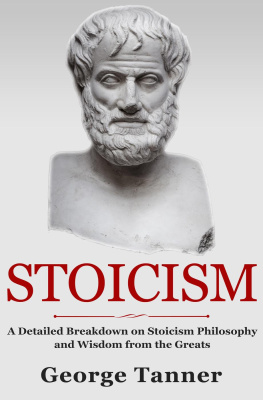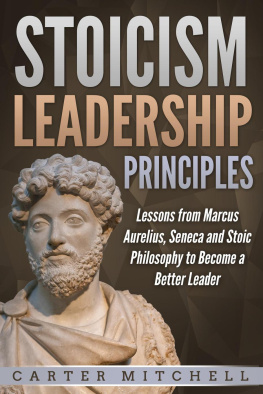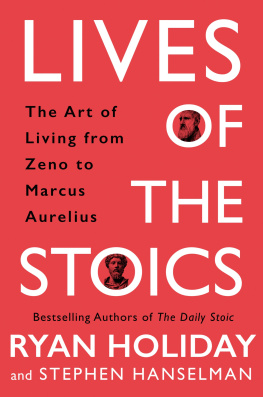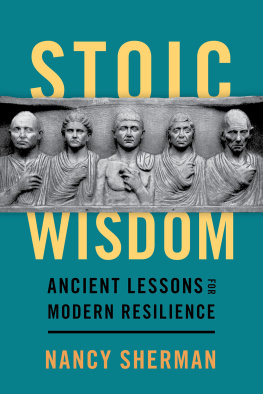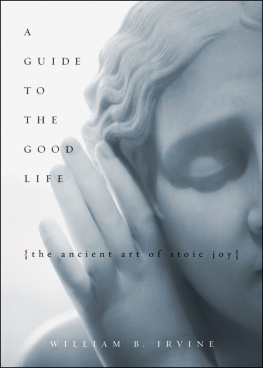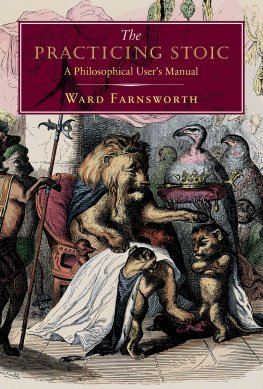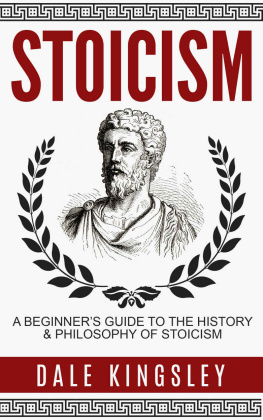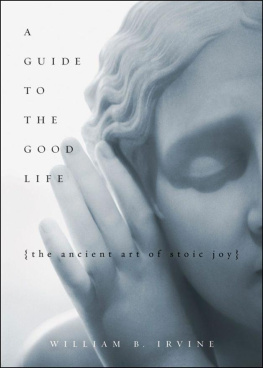
First published in 2018 by
D AVID R. G ODINE Publisher
Post Office Box 450
Jaffrey, New Hampshire 03452
www.godine.com
Copyright 2018 by Ward Farnsworth
All rights reserved. No part of this book may be used or reproduced in any manner whatsoever without written permission from the publisher, except in the case of brief excerpts embodied in critical articles and reviews. For information contact Permissions, David R. Godine, Publisher, Fifteen Court Square, Suite 320, Boston, Massachusetts 02108.
LIBRARY OF CONGRESS
CATALOGING-IN-PUBLICATION DATA
Names: Farnsworth, Ward, 1967 author.
Title: The practicing stoic : a philosophical users manual / Ward Farnsworth. Description: Jaffrey : David R. Godine, Publisher, 2018.
Identifiers: LCCN 2017053581 | ISBN 9781567926118 (alk. paper)
Subjects : LCSH : Stoics.
Classification: LCC B 528 . F 37 2018 | DDC I 88dc23
LC record available at https://lccn.loc.gov/2017053581
Hardcover ISBN: 978-1-56792-611-8
Ebook ISBN: 978-1-56792-633-0
FIRST EDITION 2018
Printed in the United States of America
CONTENTS
PREFACE
This is a book about human nature and its management. The wisest students of that subject in ancient times, and perhaps of all time, were known as the Stoics. Their recommendations about how to think and live do not resemble the grim lack of feeling we associate with the word Stoic in English today. The original Stoics were philosophers and psychologists of the most ingenious kind, and also highly practical; they offered solutions to the problems of everyday life, and advice about how to overcome our irrationalities, that are still relevant and helpful now. The chapters that follow explain the most useful of their teachings in twelve lessons.

That was a brief statement of the books purpose. The reader who finds it enough can proceed to . For those wanting a fuller account of the rationale for what follows, here is a more complete statement.
- The body of ideas known as Stoicism contains some of the finest and most durable wisdom of any age. The Stoics were deep students of desire, fear, status, emotion, and much else that bedeviled the human race thousands of years ago and bedevils it still. They were philosophers of a down-to-earth sort, seeking by force of their insights to free ordinary people from their sufferings and illusions. The Stoics had their limitations, of course; they held some beliefs that very few people do anymore. But in other ways they were far ahead of their times. They said a number of the best things that anyone ever has.
The teachings of the Stoics are as interesting and valuable now as when first written maybe more so, since the passage of two millennia has confirmed so much of what they said. The idiocies, miseries, and other discouragements of our era tend to seem novel or modern; hearing them described in a classical dialogue reminds us that they are nothing new. This itself was a claim of the Stoics: that the stories and problems of humanity dont change, but just put on new masks. The same can be said for the remedies. The most productive advice anyone offers nowadays, casually or in a bestseller, often amounts to a restatement or rediscovery of something the Stoics said with more economy, intelligence, and wit long ago. The reader does better by going straight to the sages.
- The Stoicism in this book is a set of ideas developed by philosophers in Ancient Greece and Rome. To repeat what was mentioned at the outset for it cannot be said enough Stoicism did not mean for them what the word now means to us. Stoicism usually refers in current English to suffering without complaint. Our subject is something else and more; philosophical Stoics dont do much complaining, but for them that is a small point. (A Stoic would probably be glad to complain if it helped anything.) Stoic also is sometimes thought to mean grim, which is likewise inaccurate. A Stoic is more likely to be distinguished by mild humor in the face of things regarded as grim by others. Or some imagine that Stoics seek to remove themselves from the world that it is a philosophy of retreat into oneself. Again, the opposite is true. Stoics are supposed to involve themselves in public affairs. The result of all this confusion is a minor nuisance for the student of our subject: most people dont know what Stoicism is, but they dont know that they dont know.
Stoicism got its name because Zeno of Citium (c. 334c. 262 BC ), the founder of the school, did his teaching in a public colonnade or porch (stoa) overlooking the Agora of Athens. Stoicism was known on this account as the Philosophy of the Porch, as opposed to the Philosophy of the Garden (that of Epicurus), or the Philosophy of the Academy (that of Plato), or the Philosophy of the Lyceum (that of Aristotle), with each name referring to the place where the teachings of the school were imparted. So if Stoicism sounds too forbidding because of the words popular meaning, you could try telling your family that you are studying the philosophy of the porch. They might like that. More probably, readers who take an interest in our subject will also have to get used to explaining that when they refer to Stoicism, they mean the old kind.
- Many books about the Stoics have been written already. I should say a word about why another one seemed worthwhile, and what this book does that others dont.
Stoicism has come to us largely through the works of three philosophers who lived in the first two centuries AD : Seneca, Epictetus, and Marcus Aurelius. Seneca and Marcus Aurelius were Romans; Epictetus was Greek, but he, too, lived and taught for part of his life in Rome. The works they left behind tend to be miscellaneous in character. Often they consist of notes written without much order, or sorted in ways no longer meaningful to most readers. Nor are their writings cross-referenced. As a result, what any one of the Stoics taught about a given subject, let alone what they all said, cannot easily be found in one place. Senecas comments on a topic might be spread over three letters and an essay; the same issue might be addressed at the start and end of the discourses attributed to Epictetus, or at a few different places in the journals of Marcus Aurelius. This arrangement can have its advantages (sometimes unsystematic is better), but it is inconvenient for the student of Stoic thought who wants to see it as a whole, or to gain a sense of one writers views, or the views of all of them, on a particular topic.
This book is a response to the state of affairs just set forth. It has three main features. First, it seeks to organize the ideas of the Stoics in a logical manner that might be described as progressive. Foundational principles come first, then their applications. Ive tried to put the applications into a sequence that builds naturally, and, where relevant, that follows their growth in complexity. This approach is roughly reflected in the order of the chapters, in the order of the headings within each chapter, and in the order of the discussions under each heading. Those who dont care about the progression can roam around at random; the chapters are self-contained, so you dont need to read one to understand the next. But having a framework may still make the relationships between different parts of the philosophy easier to see.
Second, the book aims to draw together the most important points that the different Stoics made about each subject and each division of it. Sometimes they spoke to different aspects of an issue; Seneca addresses one part of it, Epictetus takes another. In other cases the same topic was discussed by all the Stoics. In that event it is interesting to compare what they said and how they said it. The format lets them talk to each other.
Next page





